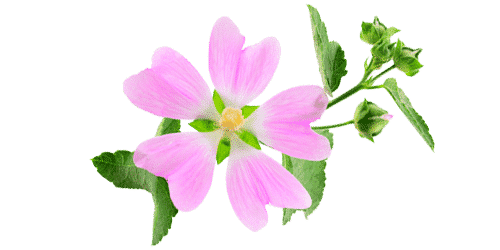
Origin
Originating in Europe and western Asia, it is an edible and decorative plant as well as a medicinal one. The mucilage in its roots is used to obtain a paste for producing confectionery, its leaves can be used to add extra flavour to salads, and its beautiful flowers are often used for decorative purposes. Also, recognised for centuries for its numerous properties, it was once used in Greek and Chinese medicine.
Did you know?
The Egyptians made confectionery by mixing the roots with honey, hence the current name of marshmallow for the sweets, which today no longer bear any relation to the plant.
Characteristics
It is a herbaceous perennial plant that can group up to 1 metre in height. Its root is white and thick, which gives it a beautiful felt-like appearance. Its oval serrated leaves are arranged into velvety leaflets. The flowers comprise a calyx and a corolla, with five pretty pinkish white petals. The root is used in phytotherapy for the numerous properties that it contains.
Flowering and harvesting
Common to Europe, marshmallow can be easily found in France growing naturally. It likes clayey soils rich in organic matter. Although it requires sunshine, it does however need a little shade to flourish and slightly moist soil for preserving the freshness of its roots. The plant blossoms in summer until autumn when it gradually loses its above-ground parts. It is at this time that the root is harvested before being dried and used in phytotherapy. You do however have to wait until the second year of flowering before harvesting the marshmallow root.
Benefits
The root of the marshmallow contains 25 to 35% mucilage, carbohydrates with 35% starch, pectin, sugars and mineral salts.1
This plant helps to:
- Facilitate digestion and transit2
The mucilage found in marshmallow helps to aid intestinal transit and therefore helps to make digestion more comfortable.
- Soothe the throat2
The mucilage also helps to soothe the throat in the case of minor irritations or a tickly throat.
1Plant-based health: 200 plants with health benefits Reader’s Digest selection, 2003. 352 p. ISBN 2-7098-1413-7
https://www.mr-plantes.com/2010/11/guimauve-althaea-officinalis/
https://www.aujardin.info/plantes/althaea-officinalis.php
https://phytotherapie.ooreka.fr/astuce/voir/273252/proprietes-medicinales-de-la-guimauve
